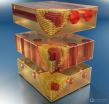(Press-News.org) Schizophrenia is a severe disease for which there is still no effective medical treatment. In an attempt to understand exactly what happens in the brain of a schizophrenic person, researchers from the University of Southern Denmark have analyzed proteins in the brains of rats that have been given hallucinogenic drugs. This may pave the way for new and better medicines.
Seven per cent of the adult population suffers from schizophrenia, and although scientists have tried for centuries to understand the disease, they still do not know what causes the disease or which physiological changes it causes in the body. Doctors cannot make the diagnosis by looking for specific physiological changes in the patient's blood or tissue, but have to diagnose from behavioral symptoms.
In an attempt to find the physiological signature of schizophrenia, researchers from the University of Southern Denmark conducted tests on rats, and they now believe that the signature lies in some specific, measurable proteins. Knowing these proteins and comparing their behaviour to proteins in the brains of not schizophrenic people may make it possible to develop more effective drugs.
It is extremely difficult to study brain activity in schizophrenic people, which is why researchers often use animal models in their strive to understand the mysteries of the schizophrenic brain. Rat brains resemble human brains in so many ways that it makes sense to study them if one wants to learn more about the human brain.
The strong hallucinogenic drug phenocyclidine (PCP), also known as angel's dust, provides a range of symptoms in people which are very similar to schizophrenia.
"When we give PCP to rats, the rats become valuable study objects for schizophrenia researchers", explains Ole Nørregaard Jensen, professor and head of Department of Biochemistry and Molecular Biology.
Together with Pawel Palmowski, Adelina Rogowska-Wrzesinska and others from a.o. Danish Technological Institute, he is the author of a scientific paper about the discovery, published in the international Journal of Proteome Research.
Among the symptoms and reactions that can be observed in both humans and rats are changes in movement and reduced cognitive functions such as impaired memory, attention and learning ability.
"Scientists have studied PCP rats for decades, but until now no one really knew what was going on in the rat brains on a molecular level. We now present what we believe to be the largest proteomics data set to date", says Ole Nørregaard Jensen.
PCP is absorbed very quickly by the brain, and it only stays in the brain for a few hours. Therefore, it was important for researchers to examine the rat brain cells soon after the rats were injected with the hallucinogenic drug.
"Already after 15 minutes we could see changes in the proteins in the brain, and after 240 minutes it was almost over", says Ole Nørregaard Jensen.
The University of Southern Denmark holds some of the world's most advanced equipment for studying proteins, and Ole Nørregaard Jensen and his colleagues used the university's so-called mass spectrometers for their protein studies.
"We found 2604 proteins, and we saw changes in 352 of them, that can be associated with the PCP injections. These 352 proteins will be extremely interesting to study in more detail to see if they are also altered in people with schizophrenia - and if that's the case, then it will of course be interesting to try to develop a drug that can prevent the protein changes that lead to schizophrenia", says Ole Nørregaard Jensen about the discovery and the work that now lies ahead.
The 352 proteins in rat brains responded immediately when the animals were exposed to PCP. Roughly speaking, the drug made proteins turn on or off when they should not turn on and off. This started a chain reaction of other disturbances in the molecular network around the proteins, such as changes in metabolism and calcium balance.
"It is these 352 proteins that cause the rats to change their behavior - and the events are probably comparable to the devastating changes in a schizophrenic brain", explains Ole Nørregaard Jensen.
The protocol for studying rat brain proteins with mass spectrometry, developed by Ole Nørregaard Jensen and his colleagues, is not limited to schizophrenia studies - it can also be used to explore other diseases.
INFORMATION:
The research was a collaboration between the University of Southern Denmark, Danish Technological Institute and NeuroSearch A/S.
Details about the experiment:
12 rats were used for the experiment. Six received an injection with the hallucinogenic drug PCP (10 mg/kg body weight), and six were injected with a saline solution to serve as controls. After 15 minutes, the first two animals in each group were killed and in less than two minutes a sample of their brain (temporal lobe) was taken and quickly frozen in liquid nitrogen. After 30 and 240 minutes the same happened with the other rats. All experiments were performed in accordance with Danish and EU guides for the handling of laboratory animals. The collected tissue samples were then subjected to various mass spectrometric protein analysis. The analysis revealed differences in the phosphorylation of proteins indicating which proteins had been affected by the drug PCP. Interpretation of the complex protein data set suggest that PCP affects a number of processes in the brain cells and leads to changes in calcium balance in the brain cells, changes in the transport of substances into and out of cells, changes in cell metabolism and changes in the structure of the cell's internal skeleton, the cytoskeleton.
This research is supported by The Villum Foundation and the Danish Ministry of Research and Higher Education (Grant No. 08-034107, Innovation Consortium "New drugs").
Contact: Ole Nørregaard Jensen, Head of Department, Professor, Department of Biochemistry and Molecular Biology, University of Southern Denmark. Tel. +45 6011 2368. Email: jenseno@bmb.sdu.dk
Protein researches closing in on the mystery of schizophrenia
2014-04-11
ELSE PRESS RELEASES FROM THIS DATE:
Development of new cell models that report circadian clock function
2014-04-11
Researchers at the University of Memphis and University of Pennsylvania report the development of robust new liver and fat cell models that report circadian clock function. These models are amenable to high throughput drug screening and could be used to find promising small molecules to resynchronize or help body clocks function normally. The consequences of modern life, eating and staying up later, shift work, cell phone addiction, and travel across time zones, all disturb internal clocks. These clocks are found in the brain where they regulate sleep, and also throughout ...
Devil in disguise: A small coral-eating worm may mean big trouble for reefs
2014-04-11
New research from the University of Southampton has identified a coral-eating flatworm as a potential threat for coral reefs.
It is barely possible to see the parasitic worm Amakusaplana acroporae when it sits on its favourite hosts, the staghorn coral Acropora, thanks to its excellent camouflage. However, the researchers found that the small flatworm could cause significant damage to coral reefs.
The scientists from the University of Southampton, who are based at the Coral Reef Laboratory in the National Oceanography Centre, Southampton, published the results of ...
Brain cell discovery could open doors to targeted cancer therapies
2014-04-11
Fresh insights into the processes that control brain cell production could pave the way for treatments for brain cancer and other brain-related disorders.
Scientists have gained new understanding of the role played by a key molecule that controls how and when nerve and brain cells are formed – a process that allows the brain to develop and keeps it healthy. Their findings could help explain what happens when cell production goes out of control, which is a fundamental characteristic of many diseases including cancer.
Researchers have focused on a RNA molecule, known ...
How nerve cells flexibly adapt to acoustic signals
2014-04-11
Researchers at Ludwig-Maximilians-Universitaet (LMU) in Munich have shown how nerve cells flexibly adapt to acoustic signals: Depending on the input signal, neurons generate action potentials either near or far away from the cell body. This flexibility improves our ability to localize sound sources.
In order to process acoustic information with high temporal fidelity, nerve cells may flexibly adapt their mode of operation according to the situation. At low input frequencies, they generate most outgoing action potentials close to the cell body. Following inhibitory or ...
Study resolves controversy over nitrogen's ocean 'exit strategies'
2014-04-11
A decades-long debate over how nitrogen is removed from the ocean may now be settled by new findings from researchers at Princeton University and their collaborators at the University of Washington.
The debate centers on how nitrogen — one of the most important food sources for ocean life and a controller of atmospheric carbon dioxide — becomes converted to a form that can exit the ocean and return to the atmosphere where it is reused in the global nitrogen cycle.
Researchers have argued over which of two nitrogen-removal mechanisms, denitrification and anammox, is ...
Forging iron women
2014-04-11
Published in the Journal of Nutrition, researchers undertook a systematic review and analysis of the effect of iron supplementation to the exercise performance of women aged from .
Lead researcher, Dr Sant-Rayn Pasricha from the Melbourne School of Population and Global Health found that iron supplementation improved women's exercise performance, in terms of both the highest level they could achieve at 100% exertion (maximal capacity) and their exercise efficiency at a submaximal exertion. Women who were given iron were able to perform a given exercise using a lower ...
Eye of the beholder -- improving the human-robot connection
2014-04-11
Researchers are programming robots to communicate with people using human-like body language and cues, an important step toward bringing robots into homes.
Researchers at the University of British Columbia enlisted the help of a human-friendly robot named Charlie to study the simple task of handing an object to a person. Past research has shown that people have difficulty figuring out when to reach out and take an object from a robot because robots fail to provide appropriate nonverbal cues.
"We hand things to other people multiple times a day and we do it seamlessly," ...
Greenland ice cores show industrial record of acid rain, success of US Clean Air Act
2014-04-11
The rise and fall of acid rain is a global experiment whose results are preserved in the geologic record.
By analyzing samples from the Greenland ice sheet, University of Washington atmospheric scientists found clear evidence of the U.S. Clean Air Act. They also discovered a link between air acidity and how nitrogen is preserved in layers of snow, according to a paper published this week in the Proceedings of the National Academy of Sciences.
Forty-five years ago, acid rain was killing fish and dissolving stone monuments on the East Coast. Air pollution rose beginning ...
Researchers develop ErSb nanostructures with applications in infrared and terahertz ranges
2014-04-11
In a feat that may provide a promising array of applications, from energy efficiency to telecommunications to enhanced imaging, researchers at UC Santa Barbara have created a compound semiconductor of nearly perfect quality with embedded nanostructures containing ordered lines of atoms that can manipulate light energy in the mid-infrared range. More efficient solar cells, less risky and higher resolution biological imaging, and the ability to transmit massive amounts of data at higher speeds are only a few applications that this unique semiconductor will be able to support.
"This ...
The taming of the shrew
2014-04-11
The Borna disease – named after the German city of Borna, which saw a cluster of cases over 100 years ago – mainly affects horses and sheep, and in rare cases cattle and rabbits too. A single case of an infected dog has been reported. Affected horses seclude themselves from the herd and suffer from depression and general disorientation. Ultimately, this incurable infection is fatal.
Borna virus detected in bicoloured shrews
Researchers have long been in the dark concerning the transmission mechanism of the Borna virus. The bicoloured shrew was one suspect, but definitive ...



